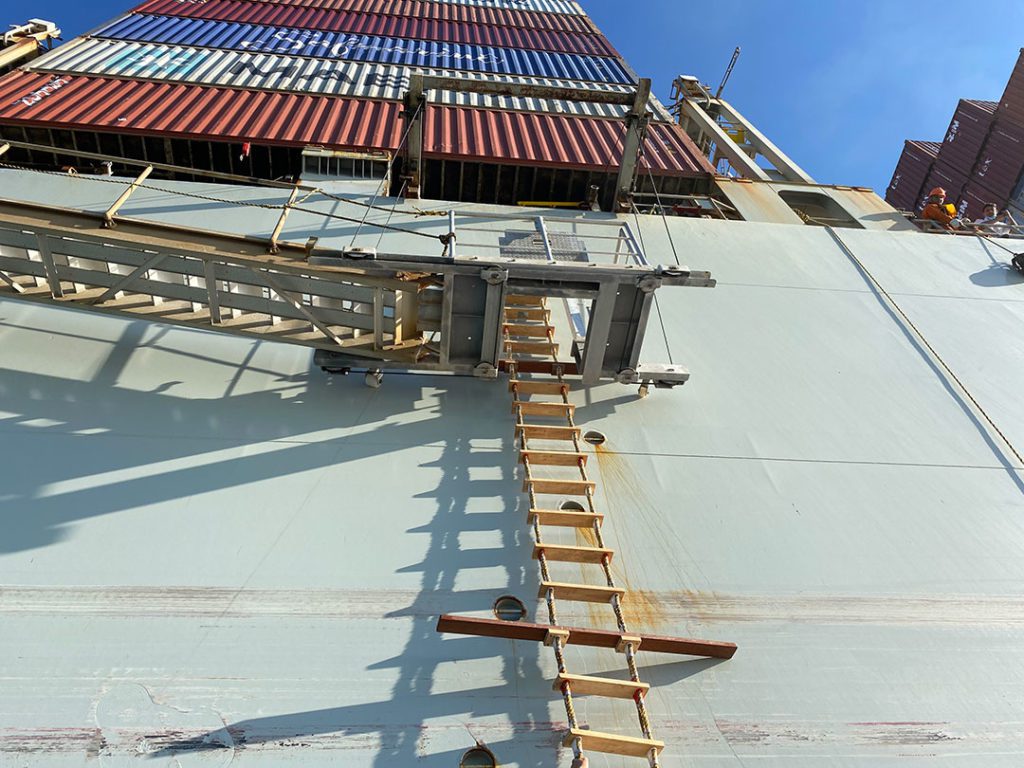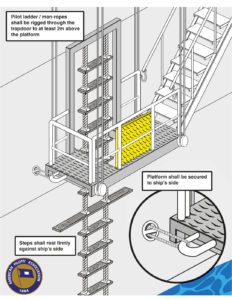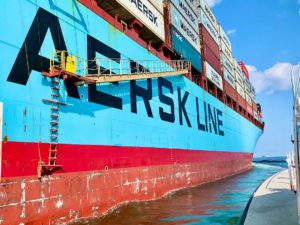
The International Chamber of Shipping has released updated guidance for the transfer of harbor pilots. The change follows industry concerns about poorly rigged ladders and other noncompliant pilot boarding arrangements.
“Shipping Industry Guidance on Pilot Transfer Arrangements,” produced by the International Chamber of Shipping (ICS) in partnership with the International Maritime Pilots’ Association (IMPA), features a new section with the International Maritime Organization’s (IMO) guidance on combination embarkation platform arrangements.
Provisions for a “trapdoor” arrangement in combination ladders, the minimum size of the opening and rigging procedures are covered in the new section.
“We continuously stress to our member pilot groups (that) as important as your job is, it’s not worth your life,” said Clay Diamond, Executive Director-General Counsel of the American Pilots Association (APA).
Two U.S. pilot fatalities in in a short time put the pilot community on high alert. In December 2019, Sandy Hook Pilots Association Capt. Dennis Sherwood, of Freehold, N.J., fell from a ladder while boarding Maersk Kensington inbound to the Port of New York and New Jersey.
Eight months later, in August 2020, Sandy Hook pilot Capt. Timothy Murray, of Malverne, N.Y., fell from a ladder while boarding the tanker Eagle Turin at the edge of New York Harbor.
In Sherwood’s case, the piloting community attributed at least some of the blame to a noncompliant trapdoor boarding arrangement.
Under the International Convention for the Safety of Life at Sea (SOLAS) regulations, a combination arrangement is required whenever the distance from the surface of the water to the point of access to the ship is more than 9 meters. A typical combination arrangement involves an accommodation platform in conjunction with a pilot ladder.
These same IMO regulations make clear that for a combination arrangement using a platform with a trapdoor, the ladder must extend through the trapdoor to at least the height of the platform’s handrail. The purpose of this requirement is to bring the ladder steps up to a level from which the pilot can step across to the platform rather than pull himself or herself up to it.
The combination arrangement deployed in the Sherwood incident, however, had the pilot ladder hanging from a crossbeam near the bottom of the platform, and with the top step of the ladder significantly below the level of the platform. This configuration would require a pilot to pull himself or herself up through the trapdoor while twisting to get a secure footing on the platform.
“It’s all too often that we encounter non-compliant and unsafe ladders and transfer arrangements,” said Capt. David Cuff, president of the Pilots Association for the Bay and River Delaware. “We have learned a lot from these incidents but it’s a shame it has to come to tragedy.”
Progress has come not in the form of new protocols or regulations, but in emphasizing the existing regulations to make sure shipping companies comply with them, said Capt. Crayton Walters, a Charleston Harbor Pilot.
“The truth is these transfer arrangements didn’t conform to SOLAS regulations, though shippers often relied on their flagged nationality to argue that they did,” he said. “So, we ended up trying to approach it from a common sense standpoint.”
Progress has been made, Walters said, with pilots becoming more discerning in what constitutes a compliant vs. noncompliant boarding arrangement. Pilots will sometimes refuse to take a ship if the arrangement appears unsafe.
“Once you refuse to take a ship, that ship has got an issue,” he said.

The APA has adopted a comprehensive prevention plan to address boarding safety. The group is working with the International Maritime Pilots’ Association, the U.S. Coast Guard, state pilot commissions, classification societies, shipping interests and international organizations, said Capt. Jorge Viso, the APA president.
The APA continues to urge pilots to know the pilot transfer arrangement rules and to report unsafe or non-compliant arrangements to authorities.
“While we are far from finished, there has been considerable progress in the past year and a half,” Viso said.
Examples of that progress includes ongoing discussions between the APA, pilot groups, shippers and regulators to improve the safety of boarding arrangements. Parties to these discussions include the American Bureau of Shipping, the IMO and the International Organization for Standardization (ISO).

Diamond pointed to shipping giant Maersk as a specific example of recent progress. In February 2021, Maersk published new guidance on pilot transfer safety. In addition, in early March 2021, Maersk reached out to the APA and provided a briefing on steps the company has planned to introduce newly designed trapdoor arrangements.
“Captain Viso has personally engaged Maersk officials and we understand that the company has made considerable progress in having all of the trapdoor arrangements in its fleet converted and/or upgraded to compliant configurations,” Diamond said.
Adding to the work done with shipping organizations, pilot organizations
are working to improve “safety culture” aboard all ships pilots will board, Viso said.
This involves stressing the message that pilots must possess a solid working knowledge of the IMO regulations and standards for pilot transfer arrangements; they must know the right person to talk to at the relevant port to report noncompliance, and to ensure these agents know the standards and regulations; they must know how to make clear and articulate deficiency reports to the Coast Guard or Pilot Commissions in the event of noncompliance.
Referring to the APA prevention plan, Diamond said, “We must continue efforts to ensure IMO pilot transfer standards are understood by all parties — shipping companies, vessel captains, regulatory agencies and pilots — and most importantly that these critical standards are enforced.”
Above all, Viso said, pilots must be ready to not do the job if they encounter a noncompliant boarding arrangement that looks unsafe.
“There is enormous economic pressure on a pilot to not delay a ship, and pilots are typically ‘type A’ people who want to get the job done,” Viso said. “That’s a cultural thing we have to overcome. The job of a pilot is vital to the economy and to environmental protection, but safety must always come first.” •
